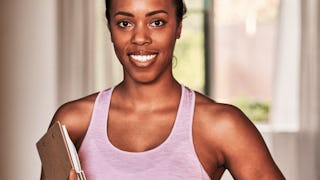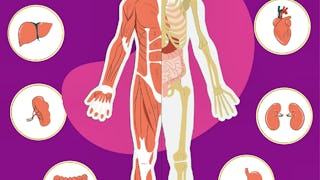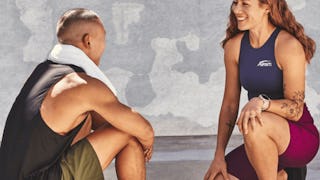In this course, you will gain the necessary scientific education that provides the groundwork for the application of safe and effective programming for fitness clients. Anatomy, Physiology, and Kinesiology are the sciences that provide the basis for fully understanding the parts of the body, how it works, and how it moves. It is vital for personal fitness trainers to have a strong understanding of anatomical structures, systems, and their functions to help guide clients in achieving their goals. By applying the understanding of Anatomy, Physiology, and Kinesiology in a fitness setting, you will be able to design and implement safe and effective exercise programs that meet the diverse needs of each client. This course will help you understand these concepts as a basis for applying them in real-world settings.



Anatomy, Physiology, and Kinesiology for Fitness Professions
This course is part of NASM Personal Fitness Trainer Professional Certificate

Instructor: Casey DeJong
8,636 already enrolled
Included with
(57 reviews)
Recommended experience
What you'll learn
Explain the roles of the nervous, skeletal, and muscular systems in human movement.
Apply principles of biomechanics and kinesiology to optimize movement patterns.
Design individualized fitness programs using knowledge of anatomy, physiology, and biomechanics.
Skills you'll gain
Details to know

Add to your LinkedIn profile
See how employees at top companies are mastering in-demand skills

Build your Basic Science expertise
- Learn new concepts from industry experts
- Gain a foundational understanding of a subject or tool
- Develop job-relevant skills with hands-on projects
- Earn a shareable career certificate from National Academy of Sports Medicine

There are 5 modules in this course
The study of the human movement system encompasses the essential principles of anatomy and physiology, focusing on the kinetic chain, which includes the skeletal and muscular systems. This comprehensive overview explores how these systems interact to facilitate movement, detailing the structure and function of bones, joints, and muscles. Emphasis is placed on understanding how posture, activity, and nutrition impact body mechanics and overall functionality. This foundational knowledge is crucial for fitness professionals dedicated to optimizing human performance and preventing injuries. Upon completion of this week’s lessons, the aspiring fitness professional will be able to:
What's included
7 videos9 readings6 assignments2 plugins
The nervous system, a complex network of billions of cells, functions as the communication hub within the human body, integrating sensory, integrative, and motor functions to maintain internal and external balance. Sensory functions allow the nervous system to detect changes in the environment, integrative functions process and interpret these sensory inputs, and motor functions generate appropriate neuromuscular responses. The system is divided into the central nervous system, comprising the brain and spinal cord, and the peripheral nervous system, consisting of cranial and spinal nerves along with sensory receptors. Understanding of how the nervous system responds to exercise is essential for developing proper movement patterns and reducing injury risk. Upon completion of this week’s lessons, the aspiring fitness professional will be able to:
What's included
2 videos6 readings5 assignments1 plugin
Understanding the basic physiological mechanisms of energy conversion is crucial before designing exercise programs for clients. Bioenergetics, the study of energy in the human body, examines how chemical energy from food is transformed into mechanical energy for muscle contractions. The cardiorespiratory system, consisting of the cardiovascular and respiratory systems, ensures the delivery of oxygen, nutrients, and waste removal for optimal cellular function. The cardiovascular system includes the heart, blood, and blood vessels, while the respiratory system manages the intake and exchange of oxygen and carbon dioxide. Additionally, the body utilizes three primary bioenergetic pathways—ATP-PCr, glycolysis, and oxidative—to produce ATP, the essential energy source for physical activity. Upon completion of this week’s lessons, the aspiring fitness professional will be able to:
What's included
5 videos7 readings6 assignments1 plugin
Biomechanics and kinesiology apply principles of physics to analyze how forces interact within the human body, focusing on the movements produced by the kinetic chain and the forces acting upon it. This includes understanding anatomical terminology, planes of motion, joint movements, muscle actions, levers, and muscle synergies. Health and fitness professionals must grasp these concepts to effectively communicate and design training programs that optimize movement and prevent injuries. Upon completion of this week’s lessons, the aspiring fitness professional will be able to:
What's included
7 videos8 readings6 assignments4 plugins
The final quiz is designed to assess your understanding and mastery of the key concepts covered throughout the course. It will include questions from all the major topics discussed in Weeks 1 to 4, ensuring that you have a solid grasp of the principles and practices of advanced personal fitness training. The final peer-reviewed assignment aims to assess your practical skills in evaluating and analyzing the kinetic chain components involved in specific exercises, explaining the function of the muscular system, using basic anatomical terminology, and understanding different types of muscle actions. By completing it, you will demonstrate your ability to analyze and assess kinetic chain components during exercise, use anatomical terminology, and understand muscle actions in various movements.
What's included
1 assignment1 peer review
Earn a career certificate
Add this credential to your LinkedIn profile, resume, or CV. Share it on social media and in your performance review.
Instructor

Offered by
Explore more from Basic Science
 Status: Free Trial
Status: Free TrialNational Academy of Sports Medicine
 Status: Free Trial
Status: Free TrialNational Academy of Sports Medicine
 Status: Preview
Status: PreviewThe Chinese University of Hong Kong
 Status: Free Trial
Status: Free TrialNational Academy of Sports Medicine
Why people choose Coursera for their career




Learner reviews
57 reviews
- 5 stars
81.35%
- 4 stars
5.08%
- 3 stars
8.47%
- 2 stars
0%
- 1 star
5.08%
Showing 3 of 57
Reviewed on Jan 3, 2025
Would have liked to see more visuals for muscular system.
Reviewed on Jul 16, 2025
Great course to help build your foundation on human movement.
Reviewed on Oct 27, 2025
I really like info and the approach of all concepts

Open new doors with Coursera Plus
Unlimited access to 10,000+ world-class courses, hands-on projects, and job-ready certificate programs - all included in your subscription
Advance your career with an online degree
Earn a degree from world-class universities - 100% online
Join over 3,400 global companies that choose Coursera for Business
Upskill your employees to excel in the digital economy
Frequently asked questions
To access the course materials, assignments and to earn a Certificate, you will need to purchase the Certificate experience when you enroll in a course. You can try a Free Trial instead, or apply for Financial Aid. The course may offer 'Full Course, No Certificate' instead. This option lets you see all course materials, submit required assessments, and get a final grade. This also means that you will not be able to purchase a Certificate experience.
When you enroll in the course, you get access to all of the courses in the Certificate, and you earn a certificate when you complete the work. Your electronic Certificate will be added to your Accomplishments page - from there, you can print your Certificate or add it to your LinkedIn profile.
More questions
Financial aid available,
¹ Some assignments in this course are AI-graded. For these assignments, your data will be used in accordance with Coursera's Privacy Notice.

